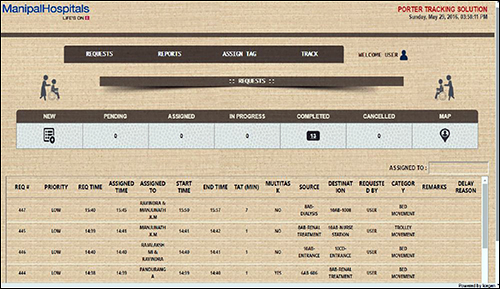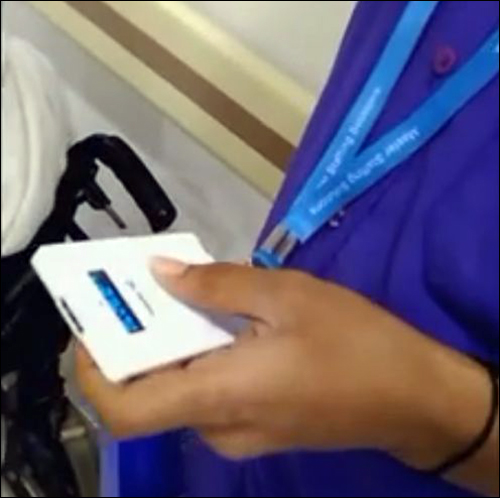When Manipal Hospitals began planning a radio frequency identification installation to make its flagship hospital operate more efficiently, it had a unique approach for its multi-phased deployment. Instead of beginning with asset tracking, it aimed at a small, potentially highly beneficial solution: managing porters who transport patients, paperwork or supplies around its facility. With the real-time location system (RTLS) in place, says Nandkishor Dhomne, the Manipal hospital group’s CIO, the facility has reduced each porter call and response time from 30 to 40 minutes down to only five or six minutes.
The porter-management system was provided by Icegen Computing, using Icegen’s software installed on the hospital’s server, in addition to Ekahau active Wi-Fi RFID badges and RTLS software to interpret the Wi-Fi signals transmitted by badges and calculate their locations. Porters are tasked with moving patients in wheelchairs and beds, as well as medicines and paperwork, throughout the hospital. The RTLS solution is designed to manage the dispatching of those porters, thereby reducing the amount of time that nurses spend waiting for them to arrive, while also reducing the number of porters required at any given time.

Manipal Hospitals, the third largest health-care group in India, comprises 13 hospitals, with three more currently under construction. Manipal Hospital Bangalore, located on Airport Road in Bengaluru (formerly known as Bangalore), has 14 floors and two wings, serving approximately 2,000 patients daily. On a typical day, Dhomne says, between 1,000 and 1,500 requests are received for porters to move a patient or item from one section of the hospital to another. With the traditional, manual method of dispatching a porter, there was typically a wait of 30 to 40 minutes between the moment when a nurse called for a porter and when he actually arrived.
Manipal Hospital Bangalore contracts its porter services to a company that provides a supervisor (stationed in the hospital’s control room) who dispatches orders, along with 30 employees who are onsite at any given time to respond to all orders received. The initial system required that a nurse make a phone call to the supervisor indicating what she needed—a porter to move a patient in a wheelchair or on a stretcher, for instance, or a trolley loaded with medication or paperwork. That supervisor then had to look through a paper record he maintained in order to determine which porters were free and where they should be in relation to the order. He then selected the unoccupied porter who should be closest to that location, and sent a message to that individual via a walkie-talkie to respond to the order. This process typically required several calls before the proper porter could be identified, after which the porter typically took about 15 to 20 more minutes to reach the requested location.
In the meantime, nurses often had to place multiple calls to find out when the porter was coming to pick up a patient who, for instance, may be getting frustrated with the wait.
If the porter picked up the requested patient or items, but failed to report to the destination in a timely fashion, the porter superintendent would need to be contacted again. The superintendent would then have to reach out to that porter via walkie-talkie.
The entire process was inefficient for both the hospital and its staff, Dhomne reports.
So when Dhomne met with Anand Surana, Icegen’s CEO, he suggested that the first use of RFID for the hospital should be tracking porters. “I said, ‘Let’s do something small but with a very large impact,'” he recalls.

The hospital already had 690 Aruba Wi-Fi access points deployed throughout its facility. Therefore, Icegen provided a system consisting of its own software and Ekahau badges. Each porter was issued a badge that transmitted a unique ID number correlated with his ID in the Icegen software. If a nurse requires a porter, she opens Icegen’s Porter Tracking Solution software on her desktop computer, presses a prompt to make her request and selects the type of task that she requires, such as moving a patient or trolley, along with the destination. In addition, Surana says, the nurse can opt to make the call urgent, by selecting that prompt in the software.
The Icegen software receives the request along with the nurse’s desktop-based location, and can then assign the porter automatically. The system searches for porters within the nurse’s vicinity, based on the transmission of those individuals’ badges, and screens out those already responding to an order. The software selects the proper recipient and the superintendent views that assignment, prompting the system to transmit a message to that porter’s badge, indicating the request. The porter then presses one of the badge’s two buttons to acknowledge receipt. If he does not acknowledge the request, the porter supervisor is alerted and can try to contact him via walkie-talkie.
Upon delivering the person or item to the desired destination, the porter presses the second button on the badge, thereby indicating that the request has been fulfilled. If the task is not completed within the expected amount of time, an alert can be issued to the supervisor. Once the porter has pressed the second button, the software updates his status as available for more orders.
Surana likens the process to Uber, in that only the provider (in this case, the porter) who is available and in the vicinity receives the request.
The Icegen software can also send alerts to the porter superintendent or hospital management, Surana says, if an unauthorized activity occurs—such as a porter leaving the premises during his shift, or stopping for an extensive period of time while transporting a patient or item.
Since the system was taken live this past spring, Dhomne says, the hospital has found that it saves 30 minutes for each order and nurses spend 80 percent less time placing that order. As a result, he says, nurses and patients are happier, and nurses have more time to perform their health-care work.
The Icegen software provides dashboards that offer analytics, such as the quantity of orders placed, how long they take to fill and each porter’s efficiency. This information helps the hospital to identify which workers it should retain.
“Before, we had no idea where a porter was. Now we know,” Dhomne says, noting that employees are identifying other opportunities for the technology as well. “They’re asking me if we can track assets such as wheelchairs, as well as carts and mobile machines.”
Since the porter-management system is providing benefits, Dhomne says, the hospital has begun tagging some of those assets, including wheelchairs and high-value mobile equipment. A new Manipal hospital is opening in December at another location in Bangaluru, he reports, and that facility will launch with the same technology in place. The Wi-Fi access points that serve as the RTLS’s infrastructure are already in operation at all Manipal group hospitals, and Dhomne says he is currently in the process of expanding the system to additional facilities. In the long run, he says, all of its hospitals will use the RTLS technology.



